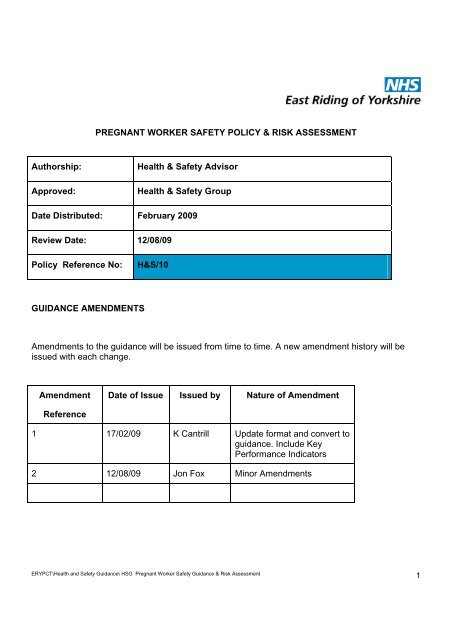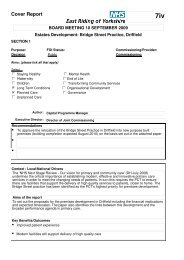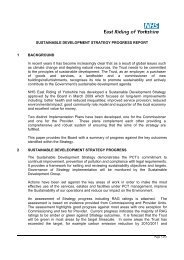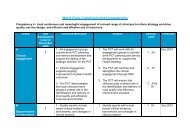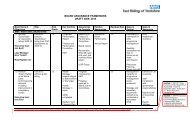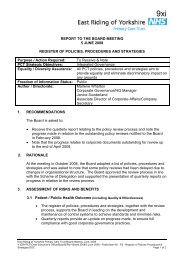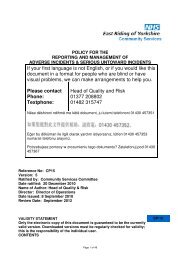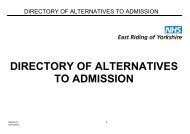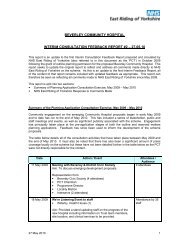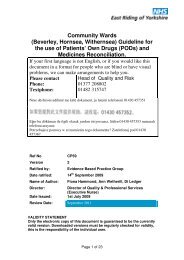PREGNANT WORKER SAFETY POLICY & RISK ASSESSMENT ...
PREGNANT WORKER SAFETY POLICY & RISK ASSESSMENT ...
PREGNANT WORKER SAFETY POLICY & RISK ASSESSMENT ...
You also want an ePaper? Increase the reach of your titles
YUMPU automatically turns print PDFs into web optimized ePapers that Google loves.
<strong>PREGNANT</strong> <strong>WORKER</strong> <strong>SAFETY</strong> <strong>POLICY</strong> & <strong>RISK</strong> <strong>ASSESSMENT</strong><br />
Authorship: Health & Safety Advisor<br />
Approved: Health & Safety Group<br />
Date Distributed: February 2009<br />
Review Date: 12/08/09<br />
Policy Reference No: H&S/10<br />
GUIDANCE AMENDMENTS<br />
Amendments to the guidance will be issued from time to time. A new amendment history will be<br />
issued with each change.<br />
Amendment<br />
Reference<br />
Date of Issue Issued by Nature of Amendment<br />
1 17/02/09 K Cantrill Update format and convert to<br />
guidance. Include Key<br />
Performance Indicators<br />
2 12/08/09 Jon Fox Minor Amendments<br />
ERYPCT\Health and Safety Guidance\ HSG Pregnant Worker Safety Guidance & Risk Assessment<br />
1
INDEX<br />
Section<br />
1 Introduction<br />
2 Legislation<br />
3 Aim<br />
4 Roles & Responsibilities<br />
5 Guidelines on Pregnant & Nursing Mothers at Work<br />
6 Monitoring<br />
7 References<br />
8 Key Performance Indicators<br />
Appendix 1 Pregnant Workers Risk Assessment Form<br />
PCT STATEMENT<br />
NHS East Riding of Yorkshire acknowledges the importance of maintaining their duty to improve<br />
the physical and mental well being of its employees and is committed to implementing measures<br />
which encourage a healthy workforce.<br />
1. INTRODUCTION<br />
This document should be read in conjunction with the PCT Health & Safety Policy which is the<br />
overarching policy for all health & safety related guidance, excluding security and fire safety issues<br />
which have their own specific policies and related guidance.<br />
The National Resources framework requires NHS Trusts both to create a healthy workplace and to<br />
improve the working lives of its employees. A number of PCT personnel policies have been<br />
developed and measures put in place which is aimed at achieving this. (Appendix 1 – List of<br />
Policies).<br />
The PCT is currently working on an improved response to the National Framework requirements<br />
through a Staff Health & Wellbeing Focus Group.<br />
This policy applies to all PCT employees irrespective of age, race, colour, religion/belief, disability,<br />
nationality, ethnic origin, gender, sexual orientation or marital status, domestic circumstances,<br />
social and employment status, HIV status, gender reassignment, political affiliation or trade union<br />
membership. All employees will be treated in a fair and equitable manner recognising any special<br />
needs of individuals where adjustments need to be made. No member of staff will suffer any form<br />
of discrimination, inequality, victimisation, harassment or bullying as a result of implementing this<br />
policy.<br />
ERYPCT\Health and Safety Guidance\ HSG Pregnant Worker Safety Guidance & Risk Assessment<br />
2
2. LEGISLATION<br />
Employers have a general duty under the Health and Safety at Work etc Act 1974 to ensure, so far<br />
as is reasonably practicable, the health of their employees at work which includes taking steps to<br />
make sure they do not suffer stress-related illness as a result of their work. The Act also places a<br />
duty on every employee to look after themselves and others in the workplace.<br />
The European Pregnant Workers Directive (92/85/EEC) introduced in 1992 affected the rights of<br />
pregnant women and working mothers in the areas of both employment and health and safety.<br />
Legislation continues in the Management of Health and Safety at Work Regulations 1999. In order<br />
to implement the directive employers are required to undertake risk assessments in the workplace<br />
specifically for new and expectant mothers or mothers who are breastfeeding. The Health and<br />
Safety Executive produced a guide for employers outlining physical, biological and chemical<br />
agents, processes and working conditions which may affect the health and safety of new and<br />
expectant mothers. The Occupational Health pregnancy risk assessment includes risk factors as<br />
appropriate to the role and working environment of the employee within the NHS East Riding of<br />
Yorkshire PCT.<br />
Some of the risk factors highlighted by the pregnancy risk assessment are also covered by<br />
separate legislation, such as the Control of Substances Hazardous to Health Regulations 1999<br />
(COSHH), the Manual Handling Operations Regulations 1992, (8) The Display Screen Equipment<br />
Regulations 1992 and the Workplace (Health, Safety and Welfare) Regulations (1992).<br />
3. AIM<br />
To ensure all employees who become pregnant undergo a risk assessment as early in their<br />
pregnancy as possible and that risks identified are controlled as far as is reasonably practical.<br />
4. ROLES AND RESPONSIBILITIES<br />
4.1 MANAGERS<br />
Are to be involved in the process of pregnancy risk assessment by, where possible attending and<br />
contributing to the assessment with Occupational Health and the employee. The process will<br />
include introducing control measures recognised as necessary through risk assessment; evaluating<br />
these with the employee and continuing to monitor and review these as necessary using the<br />
Occupational Health pregnancy risk assessment form (see Appendix 1). If a manager is unable to<br />
attend the assessment they must act upon any recommendations from the assessment. If any<br />
significant changes occur in work activities of the pregnant worker after the assessment, managers<br />
must contact Occupational Health to re-review the circumstances.<br />
Managers should also, consider health and safety issues on the workers return to work after<br />
maternity leave.<br />
ERYPCT\Health and Safety Guidance\ HSG Pregnant Worker Safety Guidance & Risk Assessment<br />
3
4.2 EMPLOYEE<br />
Advised to inform their line Manager as soon as pregnancy is confirmed. Employees are required<br />
to attend and participate in the maternity risk assessment process by examination of their own<br />
roles and environment and highlighting any perceived or significant risks.<br />
They are also required to contact their manager for re-assessment if any significant changes in any<br />
aspect of job occur after the original risk assessment.<br />
On return after maternity leave employees have an option whether to contact Occupational Health<br />
and/or manager for another risk assessment review.<br />
4.3 OCCUPATIONAL HEALTH DEPARTMENT<br />
Are available to advise both manager and employee in the risk assessment process identifying any<br />
significant risks and discussing appropriate control measures as necessary and how these can be<br />
implemented and reviewed (see the HMHTT Occupational Health Department’s Mid Employment<br />
Policy).<br />
Document the risk assessment and outcomes and keep this within the Occupational Health<br />
Department in line with the Data Protection Act 1998, ensuring a copy is sent to the manager.<br />
Where the employee is on secondment or contracted, this organisation’s policy applies, but liaison<br />
with the manager and personnel from the employing organisation may be necessary. A separate<br />
policy is used for student nurses in training.<br />
5. GUIDELINES ON <strong>PREGNANT</strong> & NURSING MOTHERS AT WORK<br />
Managers should ensure that health and safety standards within their areas of responsibility permit<br />
new or expectant mothers to work without harm to self or the unborn child. Where there is concern<br />
about the health and / or safety of a new or expectant mother at work, the employee or her<br />
manager should seek the advice of the Occupational Health or Risk Management Departments.<br />
The manager is not obligated to make any change in employment practices or arrangements until<br />
he / she has received written notification from the employee of the pregnancy. The manager can<br />
also request a certificate confirming pregnancy from the employee’s general practitioner or<br />
registered midwife.<br />
Once pregnancy has been confirmed to the manager he / she must take account of potential and<br />
actual hazards in the workplace which could adversely affect the well being of the new or expectant<br />
mother and / or unborn child. The risk assessment should be a standard and integral part of the<br />
risk assessment process and procedures. Where, as a result of the risk assessment findings, there<br />
is genuine concern regarding the hazards and associated risks, temporary changes may be<br />
required to working conditions or suitable alternative employment (in relation to the employee and<br />
circumstances) offered if the hazards cannot be controlled or eliminated. Paid leave should be<br />
given for as long as is necessary to provide suitable protection if neither option is acceptable.<br />
Normal remuneration due during suspension can be withheld if the employee has unreasonably<br />
ERYPCT\Health and Safety Guidance\ HSG Pregnant Worker Safety Guidance & Risk Assessment<br />
4
efused suitable alternative employment. The employee cannot be dismissed because she is<br />
pregnant or for any reason connected to the pregnancy.<br />
Risk assessments of the work activities of expectant mothers need to be reviewed regularly as the<br />
possibility of harm to the expectant mother and foetus may vary at different stages of the<br />
pregnancy. The risks associated with the work of breast feeding mothers will differ from those of<br />
expectant mothers. The Regulations do not place a time limit on breast-feeding. Suitable rest<br />
facilities must be provided for those employees who are pregnant or breast-feeding.<br />
5.1 HAZARDS<br />
Anaesthetic gases<br />
Pregnant employees should only work with nitrous oxide, halothane, enfluorane and isoflurane if<br />
scavenging equipment is active, properly maintained and gas levels monitored to remove waste<br />
gases. If such conditions cannot be satisfied, the pregnant employee should be re-deployed to a<br />
more suitable post. If this is unsustainable, suspension on full pay should be considered.<br />
Assault<br />
Exposing the pregnant abdomen to shocks and jolts is known to create the risks of premature birth,<br />
miscarriage and low foetal birth weight. If the risk assessment indicates that violence against health<br />
care workers is likely, the pregnant worker should be transferred to a less hazardous area of<br />
employment.<br />
Biological agents & Infectious Diseases<br />
Employers must pay particular attention to the infection hazards that could affect the new or<br />
expectant mother and her unborn child and take actions that are reasonably practicable to prevent<br />
or control the hazards. Reference should be made to the COSHH Regulations 1999 and the PCT<br />
Infection Control policies.<br />
Rubella (German Measles) (first trimester), Chickenpox (first trimester) and Cytomegalovirus have<br />
the potential to harm the foetus if the mother has not developed resistance previously. Listeria<br />
bacteria and the Toxoplasma parasite can also harm the foetus. Advice should be sought from a<br />
member of the Occupational Health Department where there is doubt as to the expectant mother’s<br />
immune status.<br />
NHS East Riding of Yorkshire PCT Infection Prevention and Control policies and procedures must<br />
be followed to minimise risk to both mother and foetus.<br />
Work-related sharps injuries, bites and skin splash incidents must be reported to the Occupational<br />
Health Department. The pregnant employee must take responsibility for following and maintaining<br />
safe working practices (e.g. using personal protective equipment provided).<br />
Pregnant laboratory workers whose work includes virus isolation may require redeployment,<br />
dependent upon the advice of a Consultant Microbiologist.<br />
ERYPCT\Health and Safety Guidance\ HSG Pregnant Worker Safety Guidance & Risk Assessment<br />
5
Chemical agents<br />
Certain chemicals have the potential to or are known to cause harm to the unborn child or breast<br />
fed babies. These chemicals can be identified by their risk phrase allocated to them (refer to the<br />
COSHH Regulations). The actual risk to health will need to be determined following a risk<br />
assessment on the use of the chemical concerned in the work place.<br />
Cytotoxic drugs<br />
There is no known maximum exposure limit or occupational exposure limit relating to cytotoxic<br />
drugs. Absorption can be by inhalation or through the skin. Cytotoxic drugs can cause damage to<br />
genetic formation in sperm or ova and some drugs are known to be carcinogenic. Therefore, it<br />
must be considered safe practice to reduce any exposure to cytotoxic drugs to as low a level as is<br />
reasonably practicable. There should be no exposure during the first trimester of pregnancy.<br />
Assessment of the risk should consider the:<br />
• Preparation and / or administration of cytotoxic drugs;<br />
• Handling the body fluids of patients being treated with cytotoxics;<br />
• Cleaning up related spillages and disposal of associated waste products.<br />
• Staff who have concerns about their health and safety in connection with cytotoxic drugs<br />
should contact the Occupational Health Department for advice.<br />
Electro-magnetic fields / waves<br />
To date, there is no firm evidence that the foetus is sensitive to the magnetic and radio frequency<br />
fields encountered in Magnetic Resonance Imaging. However, excessive over-exposure is known<br />
to cause an elevation in body temperature, which could result in excess body fatigue. The National<br />
Radiation Protection Board recommends exclusion during the first trimester.<br />
Glutaraldehyde / Formaldehyde / Methylmethacrylate<br />
The storage, use and disposal of these substances must comply with the Control of Substances<br />
Hazardous to Health Regulations 2002<br />
Environmental extraction equipment must be active, properly maintained and levels monitored to<br />
determine effective removal of waste vapour and gases. Appropriate personal protective<br />
equipment must be worn as necessary and safety procedures adhered to. The Occupational<br />
Health Department will undertake health surveillance, where necessary.<br />
ERYPCT\Health and Safety Guidance\ HSG Pregnant Worker Safety Guidance & Risk Assessment<br />
6
Heights<br />
Pregnant employees may experience problems in working at heights, for example, ladders and<br />
platforms. Dexterity, agility, co-ordination, speed of movement, reach and balance may be<br />
impaired. An increased risk of accidents will need to be considered.<br />
Lead<br />
Exposure to lead can result in infertility, abortion and still birth; therefore, woman of reproductive<br />
capacity may not be employed in certain lead processes.<br />
Once pregnancy has been confirmed, the pregnant mother may be suspended from working with<br />
lead as the lead can enter breast milk and the circulation of the foetus in utero. Blood lead levels<br />
should be monitored as part of a routine health surveillance programme.<br />
Manual handling of loads<br />
Every manual handling operation at work should be risk assessed in line with the Manual Handling<br />
Operations Regulations 1992 and the PCT Manual Handling policy and procedures.<br />
The risk assessment should take note of individual capability, the task, the load and the<br />
environment. The primary aim should be to avoid manual handling activities. Where this is not<br />
possible, the employer should consider altering the nature of the task to reduce risks and ensure<br />
the employee has received suitable and sufficient training in manual handling and has the<br />
appropriate equipment with which to undertake the task. The employee has a responsibility to use<br />
manual handling equipment, where available, and if suitable for the task.<br />
Pregnant workers are at risk from manual handling injury; for example, hormonal changes can<br />
affect the ligaments so increasing susceptibility to injury. Therefore, employees should avoid heavy<br />
and / or repetitive manual handling. In the early stages of pregnancy there is an associated<br />
increased risk of miscarriage and in the later stage there is a shift in the centre of gravity which<br />
creates additional strain on the musculo-skeletal system.<br />
Any uniform provided for the pregnant employee should allow for the changing shape during<br />
pregnancy and be of a design which permits safe movement when undertaking work related tasks<br />
Mercury<br />
Mercury is a potential reproductive hazard (that is, it can affect the foetus) which, when spilled,<br />
disperses into tiny droplets that emit a toxic vapour. Contained mercury is not a hazard.<br />
Night working<br />
Working long hours can result in fatigue, which may be exacerbated during pregnancy. An<br />
employee who normally works nights, who is pregnant and who has a medical certificate which<br />
states that her health and safety may be adversely affected as a consequence of night working<br />
must be referred to the Occupational Health Department.<br />
ERYPCT\Health and Safety Guidance\ HSG Pregnant Worker Safety Guidance & Risk Assessment<br />
7
Noise<br />
There appears to be no specific risk to new or expectant mothers or to the foetus, but prolonged<br />
exposure to excessive noise may result in increased distress and fatigue. The requirements of the<br />
Noise at Work Regulations 1989 should be sufficient to meet the needs of new or expectant<br />
mothers.<br />
Radiation<br />
Employees working in this speciality must inform their manager if they are considering becoming<br />
pregnant and when pregnant, as significant exposure to ionising radiation can be harmful to the<br />
foetus. There are lower statutory dose levels for pregnant women and their personal dose<br />
monitoring levels must take account of this.<br />
Work procedures should be designed to keep exposure of the pregnant employee to ionising<br />
radiation to below the statutory dose limit as recommended in the Ionising Radiation Regulations<br />
1999. Pregnant employees should ensure they leave a controlled area whilst x-ray films are being<br />
taken. Radiography staff should wear lead aprons and stand behind lead screens. Staff involved in<br />
taking dental x-rays should stand at least two metres from the x-ray tube and wear lead aprons.<br />
Rest<br />
Suitable rest facilities (e.g. a non-smoking environment close to toilet facilities) and breaks should<br />
be provided at work for any new or expectant mothers. A safe environment must be made available<br />
to enable an employee who is breast feeding to express and store her breast milk.<br />
Solvents<br />
The new or expectant mother should not be exposed to levels of solvents (e.g. toluene, xylene)<br />
which exceed Occupational Exposure levels)<br />
Temperature extremes<br />
Women may tolerate heat less well when pregnant, and may be more liable to heat stress,<br />
dehydration and fainting. The risk is likely to be reduced after birth but it is not certain how quickly<br />
an improvement comes about. Breast-feeding may be impaired by heat dehydration.<br />
No specific problems arise for the new or pregnant mother from working in extreme cold<br />
environments, although for health and safety reasons, suitable warm clothing should always be<br />
provided.<br />
Visual Display Screen Units (VDUs)<br />
There is no evidence to date that working with a VDU is harmful to the health of the new or<br />
expectant mother as the levels of non-ionising radiation are likely to be below those recommended.<br />
However, any employee who is anxious about potential hazards should be given the opportunity to<br />
discuss these concerns with an Occupational Health Nurse Adviser.<br />
ERYPCT\Health and Safety Guidance\ HSG Pregnant Worker Safety Guidance & Risk Assessment<br />
8
Work environment<br />
The work environment and practices may create hazards for the new or expectant mother.<br />
Examples include slippery floor surfaces, excess reach, need for prolonged standing. Risk controls<br />
should be introduced where possible when hazards are identified.<br />
Workstations<br />
A risk assessment must be undertaken of work activities, the environment in which the workstation<br />
is situated and of the workstation itself. For example, pregnant workers may experience problems<br />
in working in tightly fitting work spaces or with workstations which do not adjust sufficiently to take<br />
account of increasing abdominal size. Frequent rest breaks will help to avoid or reduce fatigue and<br />
a suitable chair will reduce the hazards of postural problems.<br />
5.2 ASPECTS OF PREGNANCY THAT MAY AFFECT WORK<br />
Apart from hazards already mentioned, there are other aspects of pregnancy that may affect the<br />
pregnant employee. The impact will vary during the course of pregnancy and effects should be<br />
kept under review. Examples include:<br />
• Morning sickness<br />
• Backache<br />
• Varicose veins<br />
• Haemorrhoids<br />
• Frequent visits to the toilet<br />
• Increasing size<br />
• Tiredness<br />
• Balance<br />
• Comfort<br />
• Dexterity, agility, co-ordination, speed of movement and reach may be impaired because of<br />
increasing size.<br />
Advice should be sought from an Occupational Health Department on the management of<br />
individuals experiencing any of the above problems.<br />
6. Monitoring<br />
This guidance will be monitored by the Health and Safety and Improving Working Lives Groups.<br />
Reports will be produced quarterly by the Health & Safety Advisor (reported adverse incidents) and<br />
Occupational Health Department for the Extended Executive Management Team (EEMT) and<br />
Health and Safety Group.<br />
ERYPCT\Health and Safety Guidance\ HSG Pregnant Worker Safety Guidance & Risk Assessment<br />
9
Methods of monitoring will include:<br />
• Responses in the annual staff survey.<br />
• Sickness & absence of pregnant workers.<br />
• Occupational Health Department activity and statistics.<br />
• PCT adverse incident reporting system.<br />
• Pregnant worker concerns presented by the staff side representatives and/or managers at<br />
the quarterly Health and Safety Group meetings.<br />
• Health and Safety performance statistics presented to the Health and Safety Group and<br />
EEMT.<br />
7. References<br />
• Health and Safety at Work etc. Act, 1974<br />
• Management of Health and Safety at Work Regulations 1999<br />
• Control of Substances Hazardous to Health Regulations 2002 (COSHH)<br />
• Ionising Radiation Regulations 1999<br />
• Manual Handling Operations Regulations 1992<br />
• Health and Safety (Display Screen Equipment) Regulations 1992 as amended 2002<br />
• Working Time Regulations 1998 as amended 2003<br />
• A Guide for New and Expectant Mothers who Work (HSE INDG 373)<br />
8. KEY PERFORMANCE INDICATORS<br />
Adverse incident reporting system<br />
Serious Untoward Incidents`s (SUI’s)<br />
Fire risk assessments<br />
Health & safety risk assessments and audits<br />
Health & safety group meeting minutes<br />
EEMT meeting minutes<br />
Occupational Health Department Reports<br />
ERYPCT\Health and Safety Guidance\ HSG Pregnant Worker Safety Guidance & Risk Assessment<br />
10
<strong>PREGNANT</strong> <strong>WORKER</strong>S <strong>RISK</strong> <strong>ASSESSMENT</strong> FORM<br />
ERYPCT\Health and Safety Guidance\ HSG Pregnant Worker Safety Guidance & Risk Assessment<br />
Appendix 1<br />
This form should be completed in the presence of the new or expectant mother and in conjunction<br />
with her manager by a designated person who has received training on the risk assessment<br />
procedure.<br />
DETAILS OF NEW OR EXPECTANT MOTHER<br />
Name D.O.B.<br />
Job title<br />
Ward / Department<br />
Directorate<br />
Working hours / shift patterns<br />
Main work tasks<br />
Pregnancy declared in writing to manager Yes / No<br />
General health and lifestyle<br />
History of pregnancy (e.g. due date, physical effects such as loss of reach, comfort, morning<br />
sickness)<br />
Please tick where applicable<br />
11
HAZARDS YES NO N/A<br />
1. Anaesthetic gases<br />
2. Assault<br />
3. Biological agents<br />
4. Confined spaces<br />
5. Cytotoxic drugs<br />
6. Electromagnetic fields<br />
7. Glutaraldehyde, Formaldehyde<br />
8. Heights<br />
9. Lead<br />
10. Manual handling<br />
11. Mercury<br />
12. Night working<br />
13. Noise<br />
14. Photocopiers<br />
15. Prolonged standing<br />
16. Radiation<br />
17. Rest<br />
18. Slippery surfaces<br />
19. Solvents<br />
20. Temperature extremes<br />
21. Uniform<br />
22. Unusual movements / posture<br />
23. Use of power tools<br />
24. VDU’s – as main part of job<br />
25. Vibration<br />
26. Work environment<br />
27. Work station<br />
28. Other<br />
Where Other has been identified as YES please give details<br />
BIOLOGICAL/INFECTIOUS DISEASES YES NO N/A<br />
Has a perceived risk been identified?<br />
To whom has this risk been referred<br />
ERYPCT\Health and Safety Guidance\ HSG Pregnant Worker Safety Guidance & Risk Assessment<br />
12
EXISTING CONTROL MEASURES<br />
Hazard Existing control measures<br />
EVALUATING <strong>RISK</strong><br />
Hazard Probability (1-<br />
5)<br />
ACTION PLAN<br />
Hazard Risk<br />
rating<br />
x Severity<br />
(1-5)<br />
Risk<br />
Ranking<br />
ERYPCT\Health and Safety Guidance\ HSG Pregnant Worker Safety Guidance & Risk Assessment<br />
= Risk rating<br />
(1-25)<br />
Risk<br />
Ranking<br />
Action required to control risk<br />
13
FURTHER INFORMATION<br />
Employee health monitoring required<br />
More detailed assessment required<br />
Further information / investigation required to complete the risk assessment<br />
Any other relevant information<br />
<strong>ASSESSMENT</strong> SIGN OFF<br />
Assessors name and title:<br />
Date of assessment:<br />
Copy of assessment to employee Yes / No Date sent:<br />
Review dated<br />
Manager to sign to accept assessment<br />
Signature<br />
ERYPCT\Health and Safety Guidance\ HSG Pregnant Worker Safety Guidance & Risk Assessment<br />
Yes No<br />
Please send a copy of this assessment to the Occupational Health Department if any<br />
significant hazards have been identified<br />
14


